Samsung offers two top models with a 4K resolution when it comes to MiniLED technology. In this test, we took a closer look at the not so "fancy" QN95D and QN90D, which we can also find under the name QN92D. Samsung proudly calls its MiniLED televisions the NeoQLED series. Thanks to this technology, the TV offers excellent contrast and high brightness, making movie watching an experience reminiscent of true cinema. During everyday use, the Tizen system performed excellently. It is fast, intuitive, and allows seamless switching between applications. We also appreciated how well the TV handles lower quality materials – traditional TV or older films looked better than we expected, and the advanced image processing algorithms did their job. This is a TV that can really enhance the viewing experience of content that isn't always in high resolution. The solar remote was a pleasant surprise for us. Although minimalist and with a small number of buttons, it turned out to be very practical – it allowed us to control not just the TV, but also other devices, like the decoder (Canal+) or soundbar. This meant we could reduce the number of remotes on the table, which immediately improved usability. Plus, solar charging – a simple idea that eliminates the need for battery replacements and aligns with eco-friendly trends. As for the picture in different conditions, the TV performs well in both bright and dark rooms. The high brightness and numerous dimming zones handle most content, although sometimes in contrasting scenes a halo effect is noticeable. The colours, however, are vibrant and natural, and the QLED coating gives them intensity. For even better results, we decided on calibration – after which the picture looked even more detailed and natural, which only confirmed our belief that QN92/QN90 is an excellent choice. And what about motion on the screen? It is absolutely fluid. The 144 Hz panel does an excellent job with dynamic scenes – fast actions, sports, games – everything looks natural and without blurring. We particularly appreciated the Auto Motion Plus Game feature, which makes games running at 30 frames look smoother, resembling 45 frames, and at 60 Hz, motion becomes even more natural, as if operating at 90 Hz. For gamers, this is a huge plus, especially since low input lag and features like the game bar further enhance the gaming experience. This is a TV that performs well in any situation – from evening screenings to gaming marathons. QN92D is a practical, well-designed TV that offers a picture quality that's really hard to ignore. An ideal choice for those looking for something more than just a regular screen for everyday content.
- Matching (Score)
- Our verdict
- TV appearance
- Where to buy
- Contrast and black detail
- HDR effect quality
- Factory color reproduction
- Color reproduction after calibration
- Smoothness of tonal transitions
- Image scaling and smoothness of tonal transitions
- Blur and motion smoothness
- Console compatibility and gaming features
- Input lag
- Compatibility with PC
- Viewing angles
- TV efficiency during daytime
- Details about the matrix
- TV features
- Apps
- Playing files from USB
- Sound
Samsung Neo QLED QN90D / QN92D vs TCL C8K
Direct compare
Neo QLED / QN92D / QN90D
C8K / QM8K

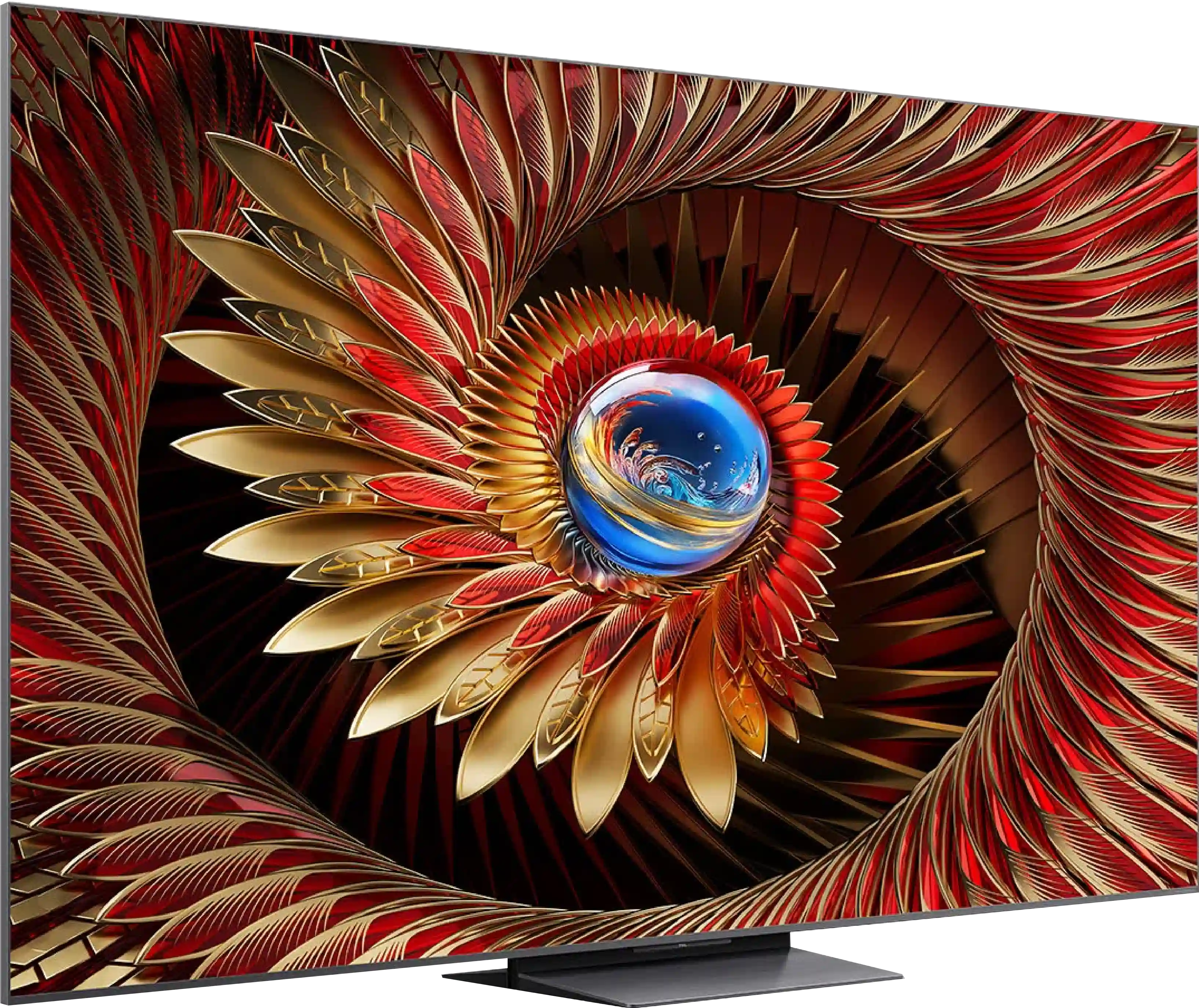
Panel type: LCD VA (wide viewing angle)
Resolution: 3840x2160
System: Tizen
Model year: 2024
Complete the survey to find out the result

Panel type: LCD VA
Resolution: 3840x2160
System: Google TV
Model year: 2025
Complete the survey to find out the result

Overall rating
7.8
7.7
Movies and series in UHD quality
7.9
7.4
Classic TV, YouTube
7.9
7.0
Sports broadcasts (TV and apps)
7.7
6.8
Gaming on console
9.1
8.9
TV as a computer monitor
8.6
8.6
Watching in bright light
6.4
6.9
Utility functions
7.4
7.7
Apps
8.7
9.6
Sound quality
6.9
7.9
Complete the survey to find out what fits your preferences
Advantages
High brightness
Good contrast
Intuitive Tizen operating system
Great for gamers and sports fans (HDMI 2.1, 144Hz, low input lag)
Wide viewing angles - unusual for VA panels
Great contrast and black levels
Very high HDR brightness
Support for all popular HDR formats
Fast 4K@144 Hz panel
Many features for gamers (VRR, ALLM, Game Bar, Low input lag)
GoogleTV operating system with many apps
Improved viewing angles thanks to WHVA panel
Very good sound: Collaboration with Bang & Olufsen
Disadvantages
No recording function
No support for DTS format - may be problematic for those using Blu-ray
No smaller variants, e.g. 55"
Very weak dimming algorithms
Colour reproduction out of the box needs improvement
Only 2 HDMI 2.1 ports and one USB.
No recording function from built-in tuners and PiP
Our verdict
The C8K is proof that premium Mini LED technology doesn't have to cost as much as a premium product. With a high number of dimming zones and a new WHVA panel, the television offers excellent contrast, deep blacks, and very high brightness – everything we expect from a good viewing experience in the living room. The improved viewing angles are also impressive, as they no longer detract from the enjoyment of watching when sitting outside the centre of the frame. The C8K also shines in the gaming world – with a 144 Hz refresh rate, support for 288 Hz in Full HD, a full set of gaming features, very low input lag, and sensible compatibility with PCs, it's hard to put down the controller or keyboard. It also comes with Google TV – currently the most advanced and versatile Smart TV platform. There is access to all the key apps, great voice control, and an intuitive interface. It may lack some classic TV features like USB recording from built-in tuners or picture-in-picture (PiP), but most users won't even notice that. On top of all this, the sound is quite decent – a new collaboration with Bang & Olufsen.
Of course, it's not a screen without its flaws. HDR, while impressive, still has some 'mini LED' traits – bright scenes can be overly bright or dimmed, and the system lacks a few classic features known from other brands. But when we consider its price in comparison to the competition, it's hard not to ask the question – why pay more?
TV appearance





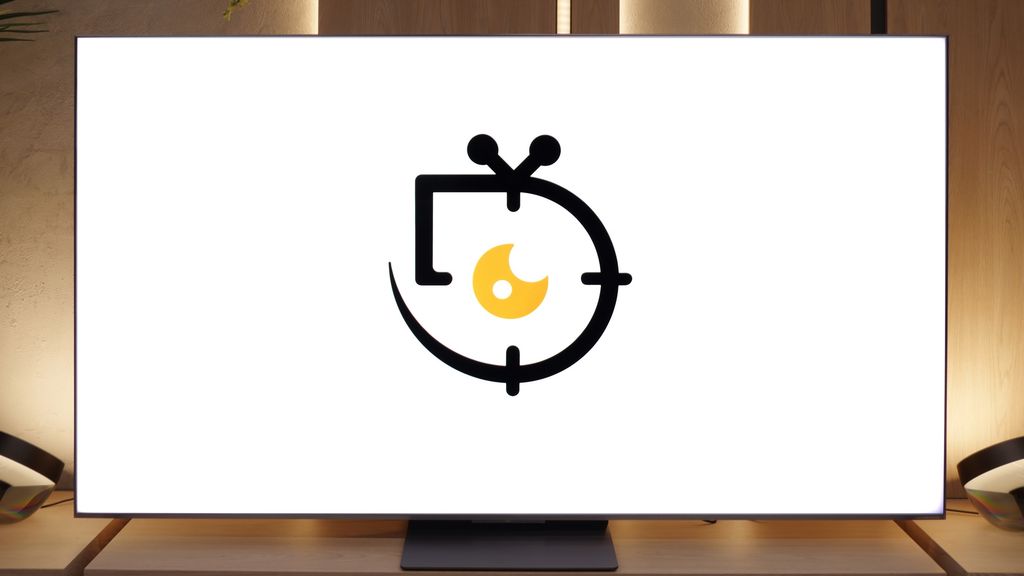
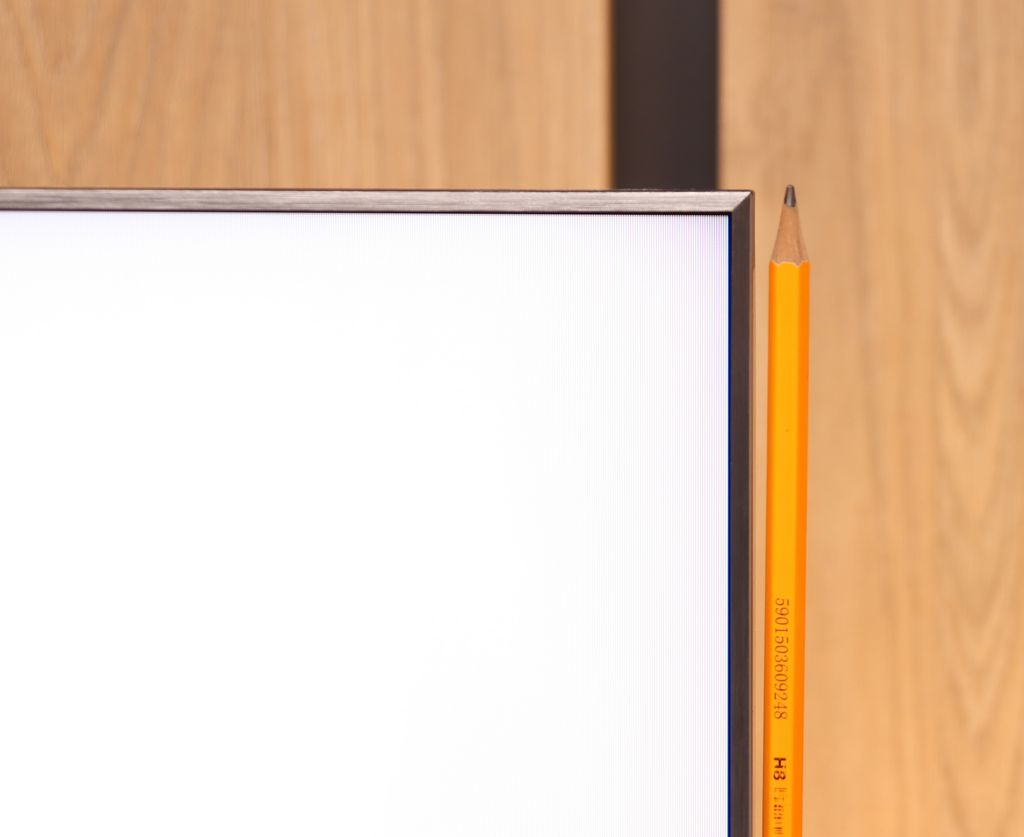
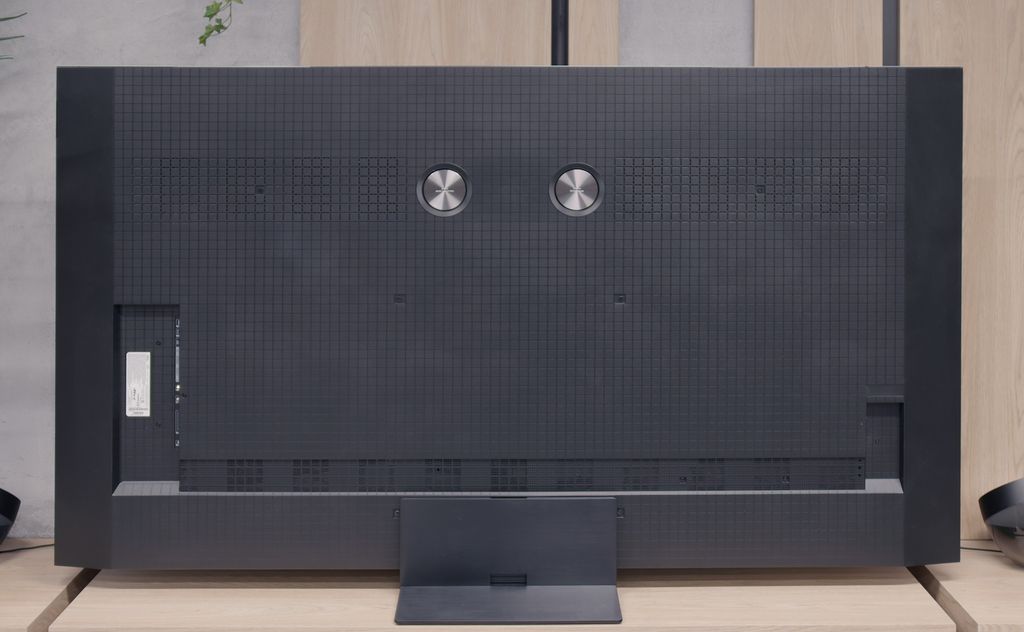
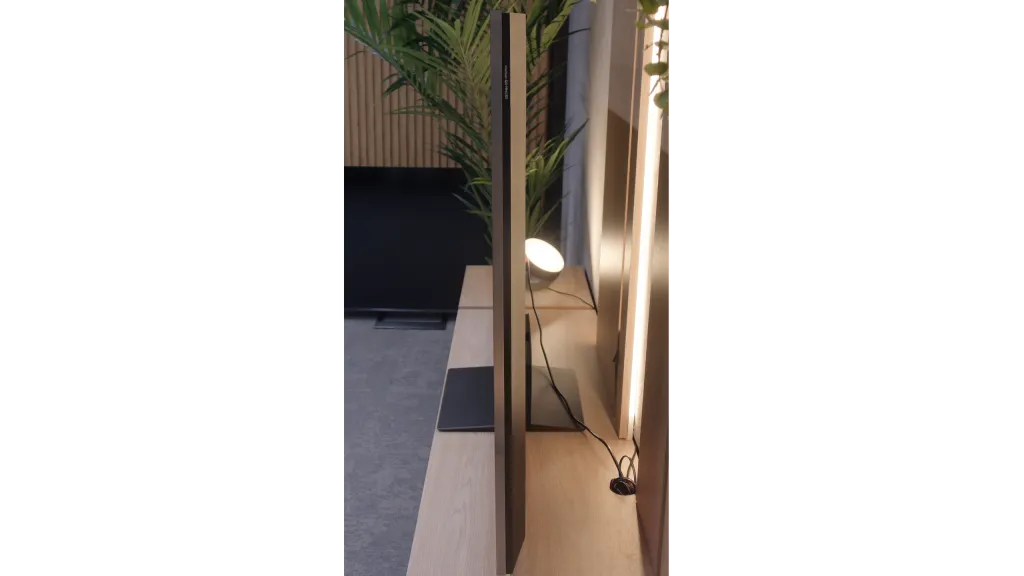
Contrast and black detail
7.9/10
8.2/10
Local dimming function: Yes, number of zones: 504 (36 x 14)
Local dimming function: Yes, number of zones: 1680 (30 x 56)
Contrast:

Result
∞:1

Result
69,000:1

Result
∞:1

Result
5,500:1

Result
2,700:1

Result
714,300:1

Result
68,100:1

Result
25,050:1

Result
17,800:1

Result
12,500:1
Halo effect and black detail visibility:

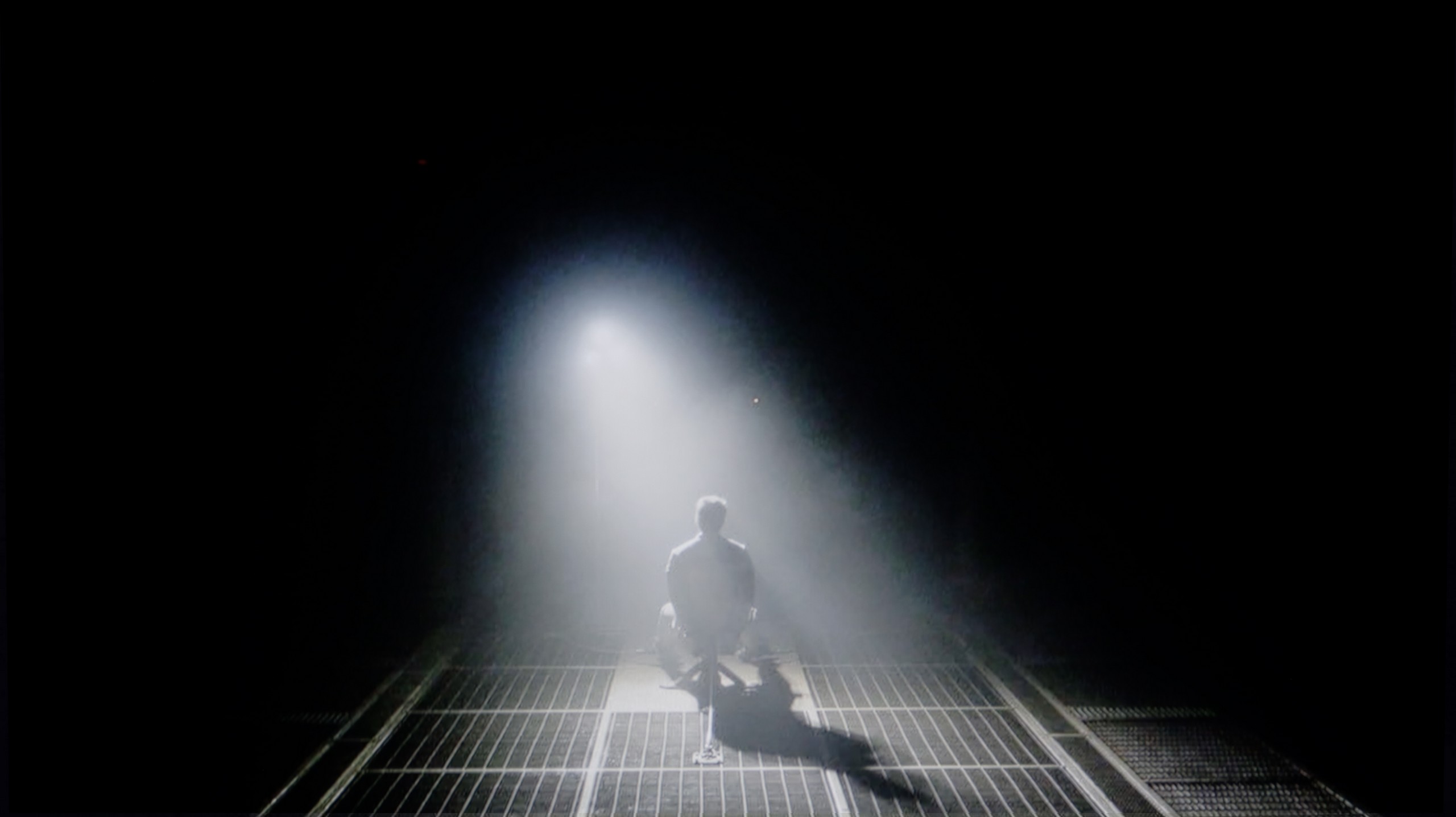
Samsung QN92D is one of the top models of NeoQLED 4K (mini LED) from the Korean manufacturer for 2024. Although it does not offer as many dimming zones as its more refined sibling Samsung QN92D, the number of 504 dimming zones in the 55-inch version is still impressive. The VA panel works well with this solution, providing excellent results in terms of contrast. The contrast in Samsung QN92D is outstanding for a non-OLED television. Even in difficult scenes, like those from the movies "Oblivion" or "Arrival," the contrast is nearly infinite and can compete with the best televisions in the OLED segment, which is quite unusual among LED-lit televisions. However, mini LED diodes have their limitations compared to organic panels, which can lead to some issues. For example, on the last test screen from Pioneer, the television has significant difficulties. This may be due to a very aggressive dimming algorithm, which sometimes causes the mini LED diodes to struggle with what to do – whether to illuminate certain elements or maintain the blacks. Despite these drawbacks, Samsung QN92D is one of the best LCD televisions in terms of contrast and blacks.
TCL C8K is a representative of the Mini LED class of TVs and – importantly – it uses a VA panel. This means high native contrast right from the start, but the true strength of this model reveals itself only when we combine it with an impressive number of dimming zones. In the 75-inch version we tested, we counted nearly 1700 independent zones – and you can feel it. In many scenes, the effect of black levels and contrast is nothing short of phenomenal. In less demanding scenes – where dimming algorithms don’t have to “work hard” – the screen can resemble OLEDs. The contrast can be nearly infinite, and the separation between bright and dark elements makes a fantastic impression.
However – as is often the case with Mini LEDs – this is not an organic screen, and some compromises have to be expected. Brightness is a huge asset, but it can also reveal the weaknesses of this solution – especially in dark scenes. Parts of very challenging scenes to display – such as those famous ones with a starry sky or sequences from the iconic Pioneer Kuro – become noticeable with what’s known as haloing, which is a glow around small bright details. Sometimes the whole screen also lightens slightly when the system tries to reconcile contrast with extreme luminance. However, this is a characteristic of the technology, not a flaw of a specific model. And although such compromises can somewhat diminish the final impression in certain scenes, TCL C8K is among the very best when it comes to contrast among Mini LED TVs.
HDR effect quality
6.7/10
6.9/10
Luminance measurements in HDR:

Result
1947 nit

Result
617 nit

Result
738 nit

Result
271 nit

Result
1479 nit

Result
1241 nit

Result
510 nit

Result
1180 nit

Result
375 nit

Result
1421 nit
Scene from the movie “Pan” (about 2800 nits)


Scene from the movie “Billy Lynn” (about 1100 nits)


Static HDR10


Dynamic: HDR10+
Dynamic: Dolby Vision


HDR luminance chart:
TCL C8K
HDR luminance
Samsung Neo QLED QN90D / QN92D
HDR luminance
During synthetic tests, Samsung QN92D showed its incredible capabilities in terms of brightness. The charts clearly indicate that the television can achieve an impressive 2000 nits, giving it a solid power base to compete with the best models on the market. Such a result places it at the forefront, especially in the context of displaying HDR content, where brightness plays a key role. However, what happens when we move the tests to real film scenes? In favourable conditions, such as the first scene from the movie Life of Pi or the last scene, where the image is completely flooded with light, Samsung QN92D can achieve almost laboratory results, impressing with its brightness. The situation looks different when small, bright objects appear on a dark background, as in the fourth scene from the movie Sicario. In such cases, the television doesn't perform as well – brightness drops several times, and maximum values in the best conditions are around 600 NITS. Similar to contrast, these limitations arise from the use of an aggressive local dimming algorithm. This algorithm aims to reduce the 'halo' effect around bright objects on a dark background, but often at the expense of overall brightness. As a result, while the television performs well in bright scenes, its ability to display full brightness is limited when it comes to small, vivid elements.
TCL C8K is a really bright television. In synthetic conditions – that is, during tests with brightness charts – it was able to achieve even 3500 nits peak brightness in movie mode. That's an impressive result and brings the C8K close to the market leaders, at least when it comes to panel brightness. More importantly – these aren't just numbers on paper. In films with a lot of bright scenes, such as Life of Pi or The Meg, the brightness clearly exceeds 1000 nits, providing a true sense of HDR effect. The picture in those moments looks very dynamic, colors are saturated thanks to excellent coverage of the color palette, and the lights are – spot on and intense. Exactly how it should be.
However, this doesn’t mean that everything is perfect. Just like in contrast tests, here too, in more demanding scenes, compromises appear. In sequences with very fine light elements – such as stars in the night sky or reflections in dark rooms – the local dimming algorithm can… get confused. Instead of bringing those details up, the television sometimes decides to dim them significantly – down to around 300 nits – to maintain deep blacks. On one hand, this is quite a sensible approach (better deep black than a grey/navy blue screen), but on the other – there may be moments when certain elements of the picture become difficult to see or even disappear into darkness.
TEST UPDATE (20/08/2025): The brightness control algorithm in this model is quite problematic – attempting to calibrate the picture so that it doesn’t drastically overexpose the brightest scenes results in unnatural shifts: improvement in one part of the image results in deterioration in another. The television may achieve slightly higher readings in brightness measurements, but in practice, this comes with a heavily overexposed image that looks very unnatural!
For the record, we provide brightness values without this adjustment:
1463 nits
640 nits
1368 nits
468 nits
1025 nits
Factory color reproduction
6.1/10
4.8/10


Factory Mode
After calibration
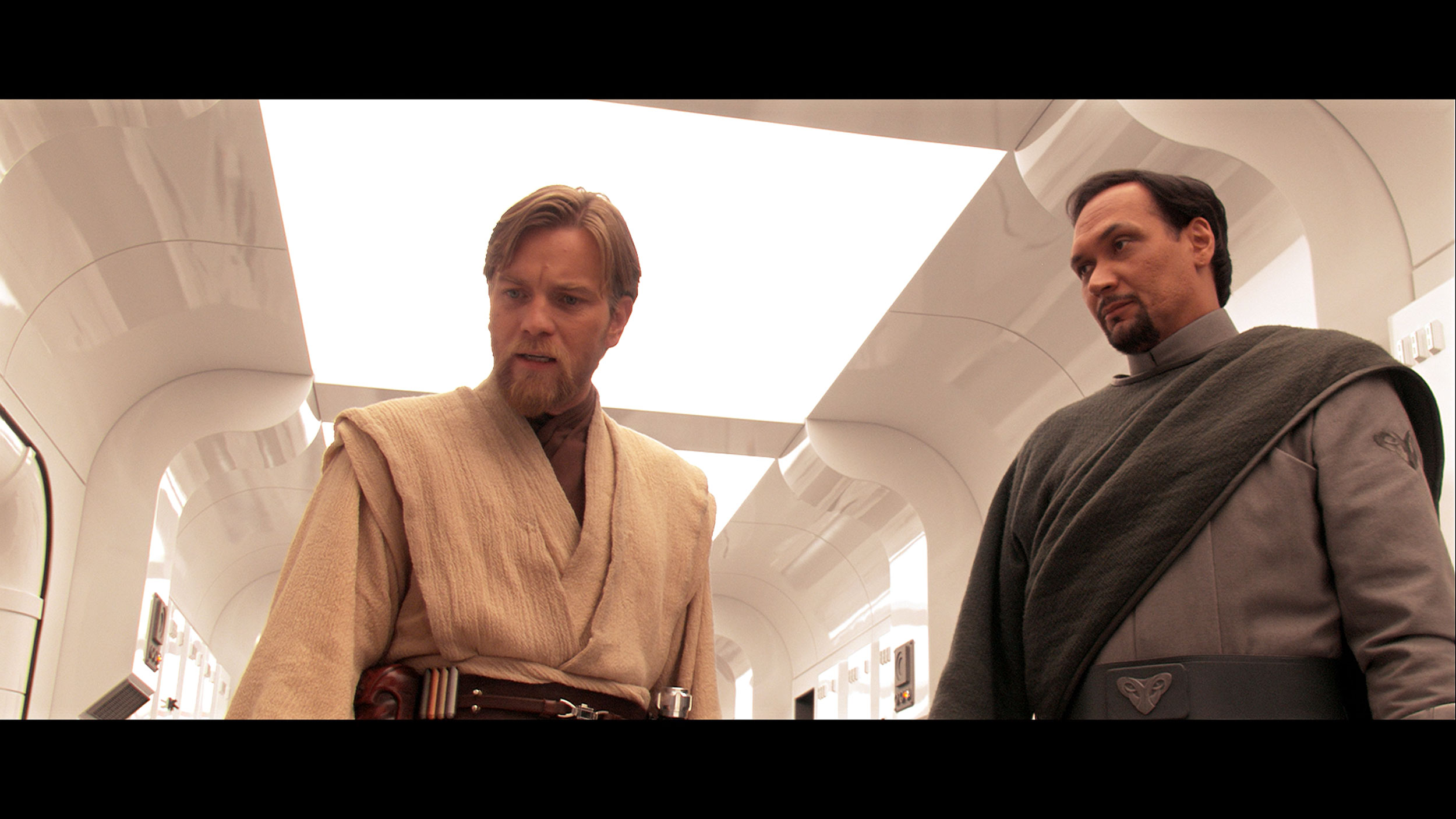

Factory Mode
After calibration
The best mode that reproduces colours best on the Samsung QN92D has consistently been the Filmmaker mode for years. While it generally offers decent colour quality, it is not free from significant issues. Let's start with the analysis of HD/SDR image quality. The biggest challenge here is the white balance – the graphs show considerable instability, with a clear dominance of red making the image too warm. This distortion causes hues to be unnaturally shifted towards warmer tones, which can negatively affect the perception of materials with natural colours. Contrast, based on the gamma chart, although not the worst, remains far from ideal, impacting the overall image quality, especially in darker scenes.
This issue also persists with 4K materials, such as series or films of higher quality. In this case, the white balance also turns out to be faulty, with noticeable deficiencies in blue and red colour, leading to tonal shifts. Tests using the Colour Checker tool confirm these problems – all colours tend to skew towards yellow shades, further distorting the natural appearance of the image. Although the Filmmaker mode is one of the best available modes for watching cinematic content, it still requires improvements, especially in terms of colour accuracy and white balance.
In the C8K, a new picture mode has appeared: Filmmaker Mode. This is something we've known for years from televisions of other brands – a mode designed to deliver the director's vision as faithfully as possible, without unnecessary image enhancements. Unfortunately, at TCL, it seems to still be in the "to be refined" stage. Right from the first glance, the screen appears too warm – the image veers into reds, which may not appeal to everyone. The white balance was markedly skewed – the screen looked distinctly warm, and the red colour dominated almost every scene. There was a lack of blue, which led to an unpleasant yellowing and distortion of the image. But that’s not all. Regardless of whether we were watching regular TV, YouTube, or HDR films – the television had a clear tendency to excessively brighten the image. In tests of gamma curves and EOTF, the lines strayed instead of adhering to the standard, resulting in an overly bright and less contrasting image. Additionally, in colour reproduction tests, significant deviations were noticeable – on the colour wheel, some points were actually "drifting away." It must be said plainly: Filmmaker Mode in the C8K, in its current form, is not very cinematic.
Color reproduction after calibration
8.7/10
7/10

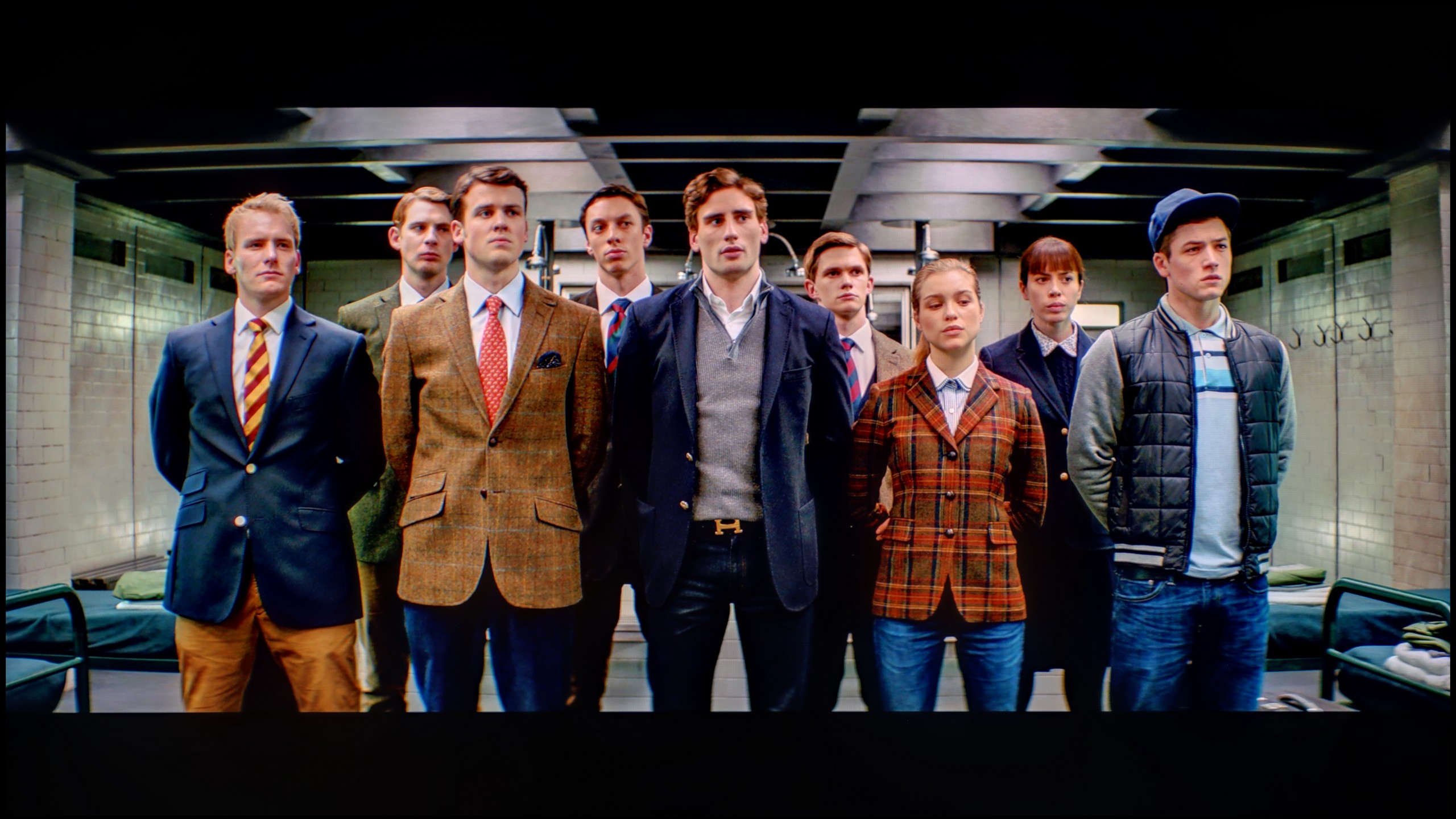


After calibration, the Filmmaker mode on the Samsung QN92D television shows significant improvement, particularly in the SDR content range. The white balance has been greatly enhanced – the previous colour misalignment and dominance of red have been eliminated, resulting in a more natural colour reproduction. In terms of brightness, although the gamma chart did not require significant adjustments, it has been stabilised, which affects the overall picture quality.
Regarding high-quality materials, the white balance has also improved in this case. However, it is worth noting the contrast. The EOTF curve, which illustrates the values in this area, appears correct at first glance. However, upon closer inspection, the television struggles to maintain appropriate contrast in film materials. The EOTF curve reveals some discrepancies, suggesting that despite the progress, there are still areas that require improvement in this aspect. The television continues to strive for excellence in contrast reproduction. A strength of this television is the saturation of colours. Skin tones are rendered very well, and although some colours may be slightly oversaturated, the overall effect looks really attractive – the colours appear rich and vibrant.
Despite some shortcomings in contrast, after calibration, the Filmmaker mode on the Samsung QN92D offers excellent image quality, with natural colour reproduction, making it a great choice for watching movies.
After professional calibration, the TCL C8K has made a huge leap forward. In SDR content, the white balance has been almost perfectly set – the screen has finally stopped being too warm and has taken on a neutral character. The gamma curve, which is responsible for how brightness is represented, now looks very good – the image is more coherent and realistic. In HDR content, we also improved the white balance – within the limits of what the television itself allows. Unfortunately, the C8K still interprets brightness management a bit "in its own way." When we look at the EOTF chart in films, it’s clear that the television brightens entire scenes more than it should. Before calibration, this effect was quite bothersome – now the situation is much better, although it still falls a bit short of perfection. This, however, is a limitation of the device itself, which – despite our efforts – does not allow us to fully tame its nature.
Smoothness of tonal transitions
9/10
8.7/10





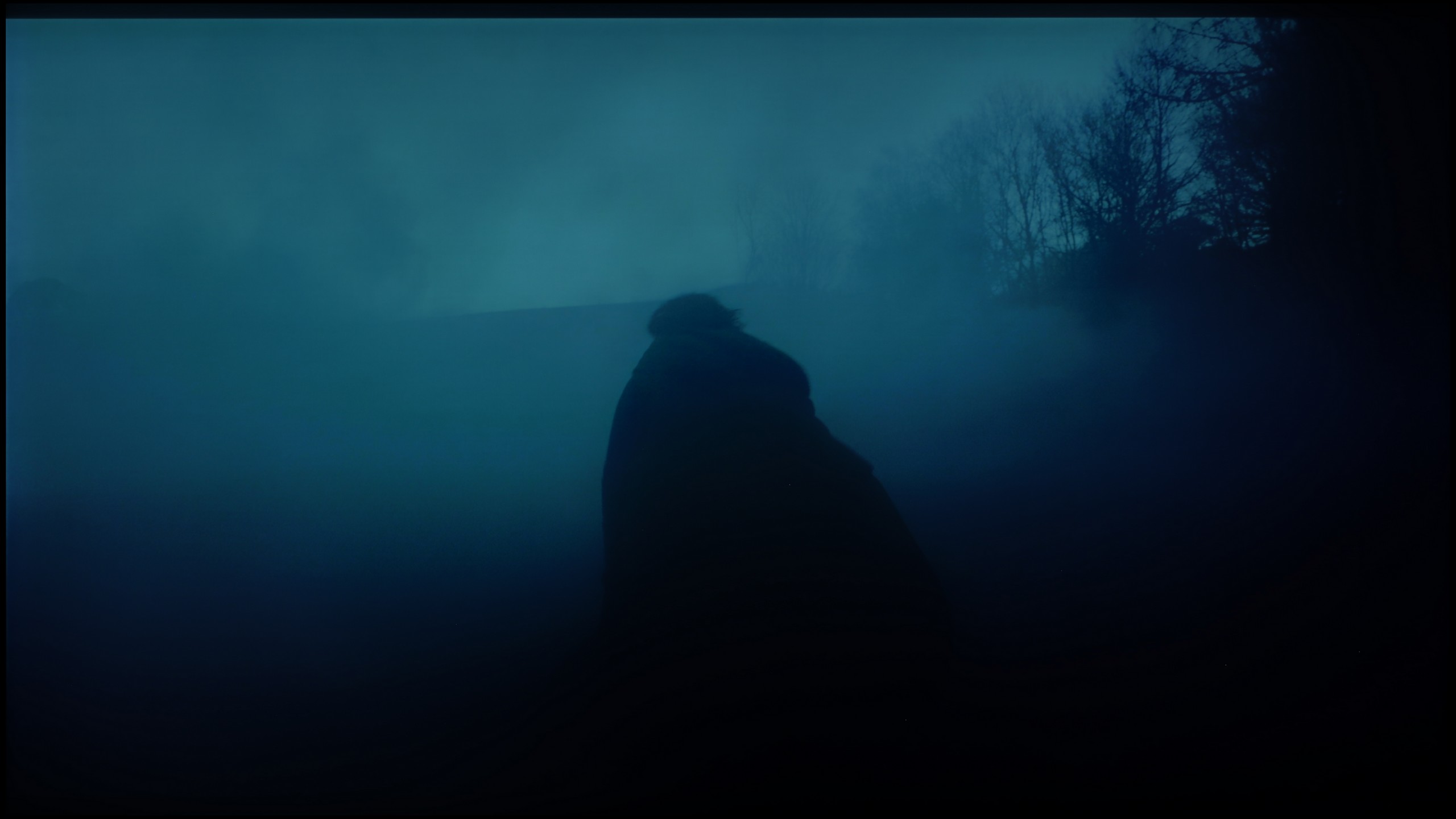






The fluidity of tonal transitions on the Samsung QN92D TV is excellent, making the image look exceptionally natural, without visible disturbances. In scenes with complex colour gradations, the TV performs brilliantly, providing smooth and uniform transitions. Competing OLED TVs in a similar price range could successfully take a cue from this, as the Samsung QN92D offers quality that places it on par with models equipped with QD-OLED panels.
In this regard, the TCL C8K performs really well. The transitions between colours look natural and cohesive – there are no strange bands or strong banding that could disrupt the viewing experience. Especially in bright scenes, everything looks very smooth. In the darkest parts of the image, particularly in shades of grey, you might occasionally notice slight inconsistencies, but they are subtle enough that they shouldn't bother anyone.
Image scaling and smoothness of tonal transitions
7.2/10
5.5/10
Smooth transition function

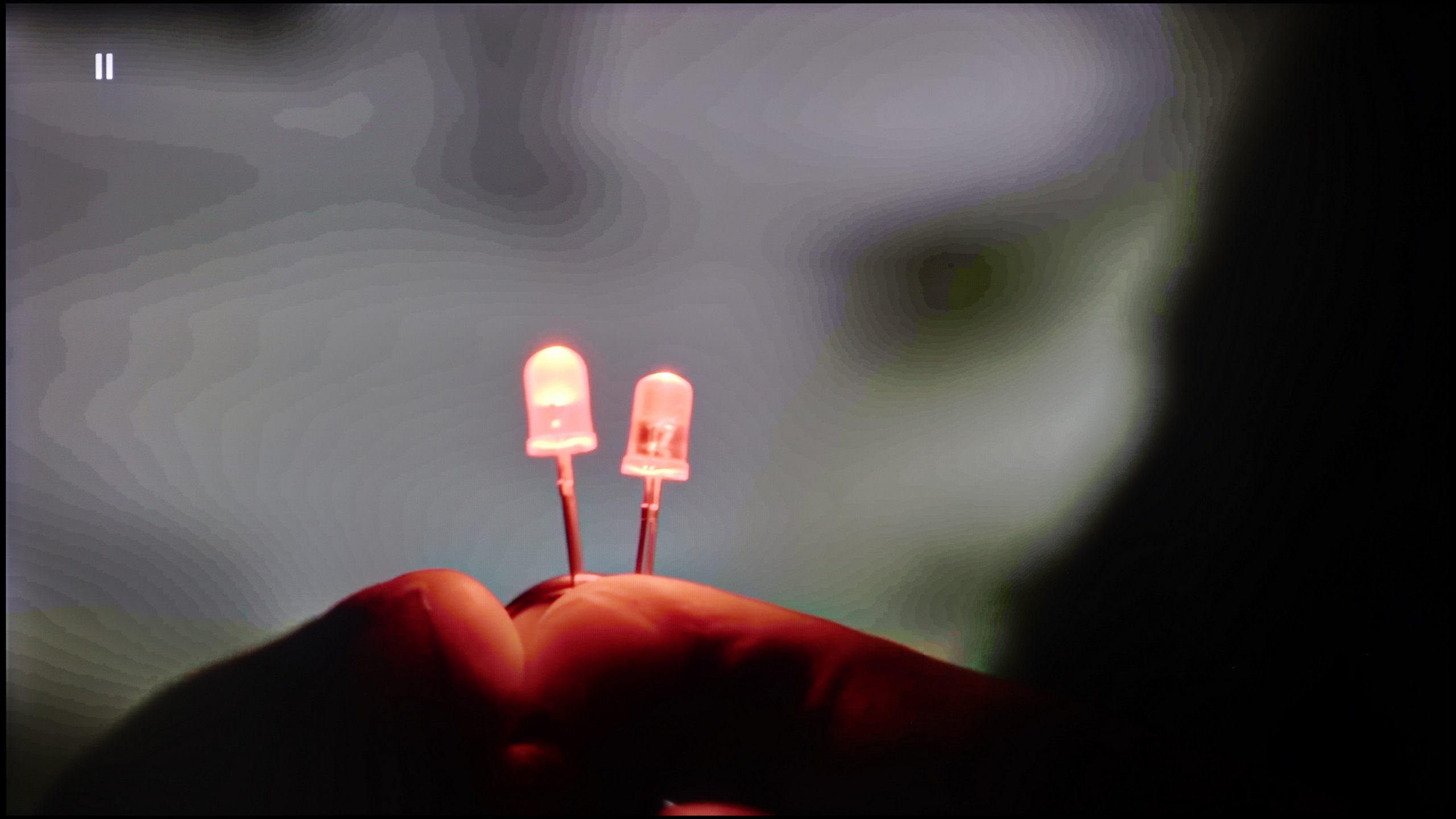
Image without overscan on the SD signal


Let's check how the Samsung QN92D TV performs with tonal transitions in very poor quality materials. The noise reduction feature shows good effectiveness, improving the fluidity of tonal transitions even in difficult conditions. However, it should be noted that, similar to other Samsung TVs, the effectiveness of this feature can lead to the removal of desirable elements, such as film grain, which can sometimes affect the authenticity of the image.
When it comes to digital processing, the Samsung QN92D TV also performs excellently. During tests, the image looked very good, with the model presented in a natural and correct way. Details, such as branches in the background, were reproduced with great precision, highlighting the TV's ability to enhance the quality of low-resolution materials.
How does the TCL C8K handle lower quality materials? One could say: fairly well, though without much enthusiasm. The television offers a tonal transition enhancement feature designed to smooth out unwanted gradients. In practice, there's a slight improvement visible, but it's not at a level that eliminates all imperfections. The feature subtly softens harsh transitions, but it doesn't work miracles. Film grain isn't completely suppressed, and subtle banding on grey backgrounds can still be noticeable. But maybe that's for the best? – at least the image doesn't lose its texture or depth, as is often the case with televisions that overdo digital processing. When it comes to upscaling, which is enhancing picture quality from lower resolutions, the C8K performs quite well. The image is sharp, and details – though sometimes a bit softened – remain discernible. However, it's not on par with the best picture processors from the competition. On the plus side, there's no issues with overscan, which is the artificial cropping of the image that can still surprise in some models from other brands.
Blur and motion smoothness
7.5/10
7.8/10

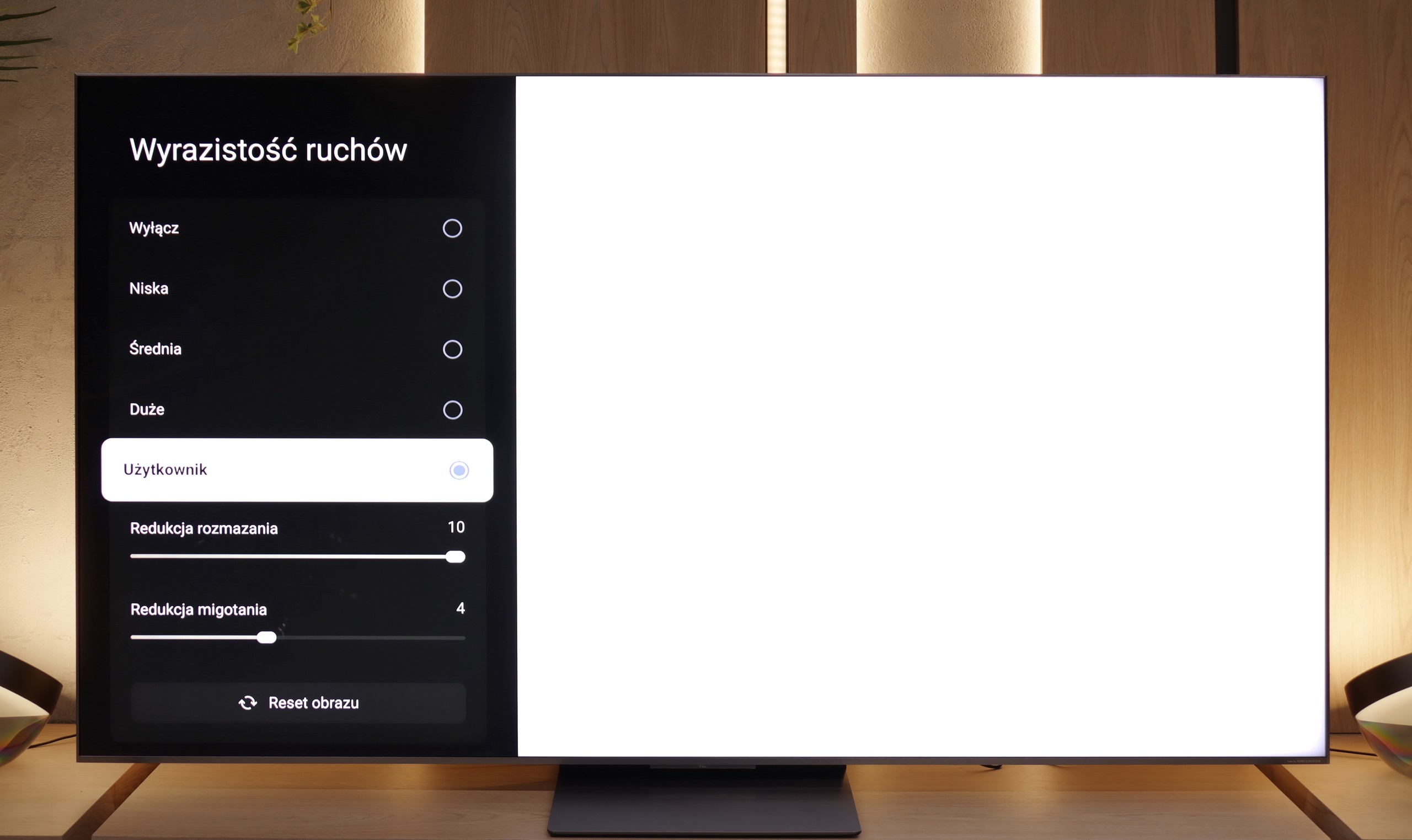
Blur (native resolution, maximum refresh rate):





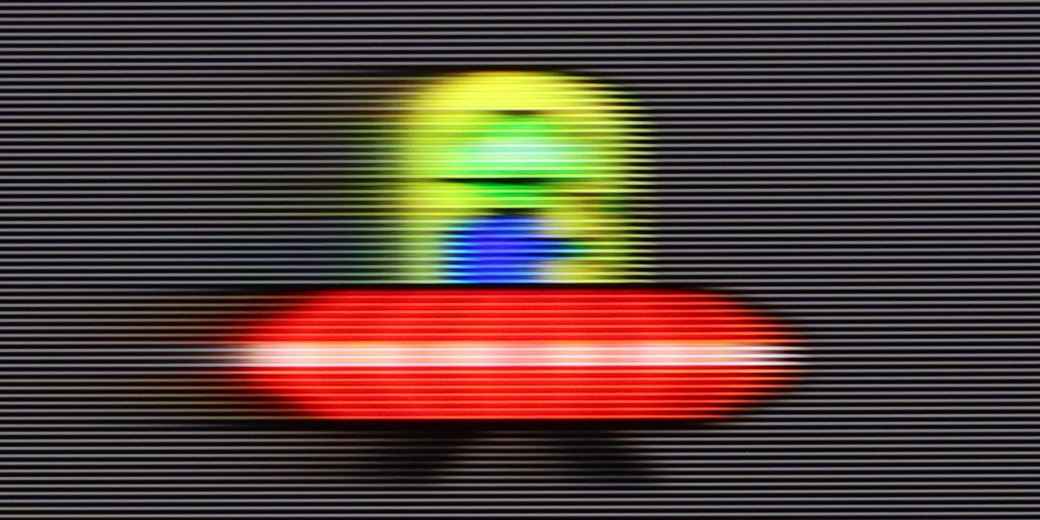
Blur (BFI function enabled):
Image flickers in this mode






Smużenie ():
Smużenie (288HZ 1080p):



The Samsung QN92D television is equipped with a 144 Hz panel; however, when watching content using the smoothness feature, the maximum refresh rate is 120 Hz. As a result, both gamers and sports enthusiasts will be satisfied with the picture quality. It’s also worth mentioning the available options for image enhancement, such as the "motion blur and judder reduction" feature, which allows users to adjust smoothness to their individual preferences on a 10-point scale. Motion blur reduction increases the sharpness of fast-moving objects, while judder reduction smooths out motion, eliminating the "stutter" effect. With these advanced settings, one can achieve optimal visual experiences, making the Samsung QN92D perfect for both dynamic scenes and intense gaming.
In terms of motion blur, the television performs really well, and it’s hard to pick faults. The only note we might have is a slight overshoot effect noticeable on dark backgrounds during our test with "Ufoludkiem." Nevertheless, thanks to the advanced smoothness settings, the Samsung QN92D excels in both dynamic scenes and intense gaming.
If you're planning a weekend with the Champions League or a marathon of F1 racing – the TCL C8K won't let you down. The television is equipped with a 144 Hz panel, so it should inherently handle fast motion well. And indeed – it performs very well. The fluidity of motion is at a very good level here, and the "Motion Clarity" feature with two sliders (blur reduction and flicker reduction) allows you to easily adjust the effect to your own preferences. Want to slightly smooth things out – no worries. Prefer a cinematic look – no problem.
Console compatibility and gaming features
9.5/10
9.8/10
- ALLM
- VRR
- VRR range48 - 144Hz48 - 288Hz
- Dolby Vision Game Mode
- Correct implementation of HGIG
- 1080p@120Hz
- 1440p@120Hz
- 4K@120Hz
- Game bar

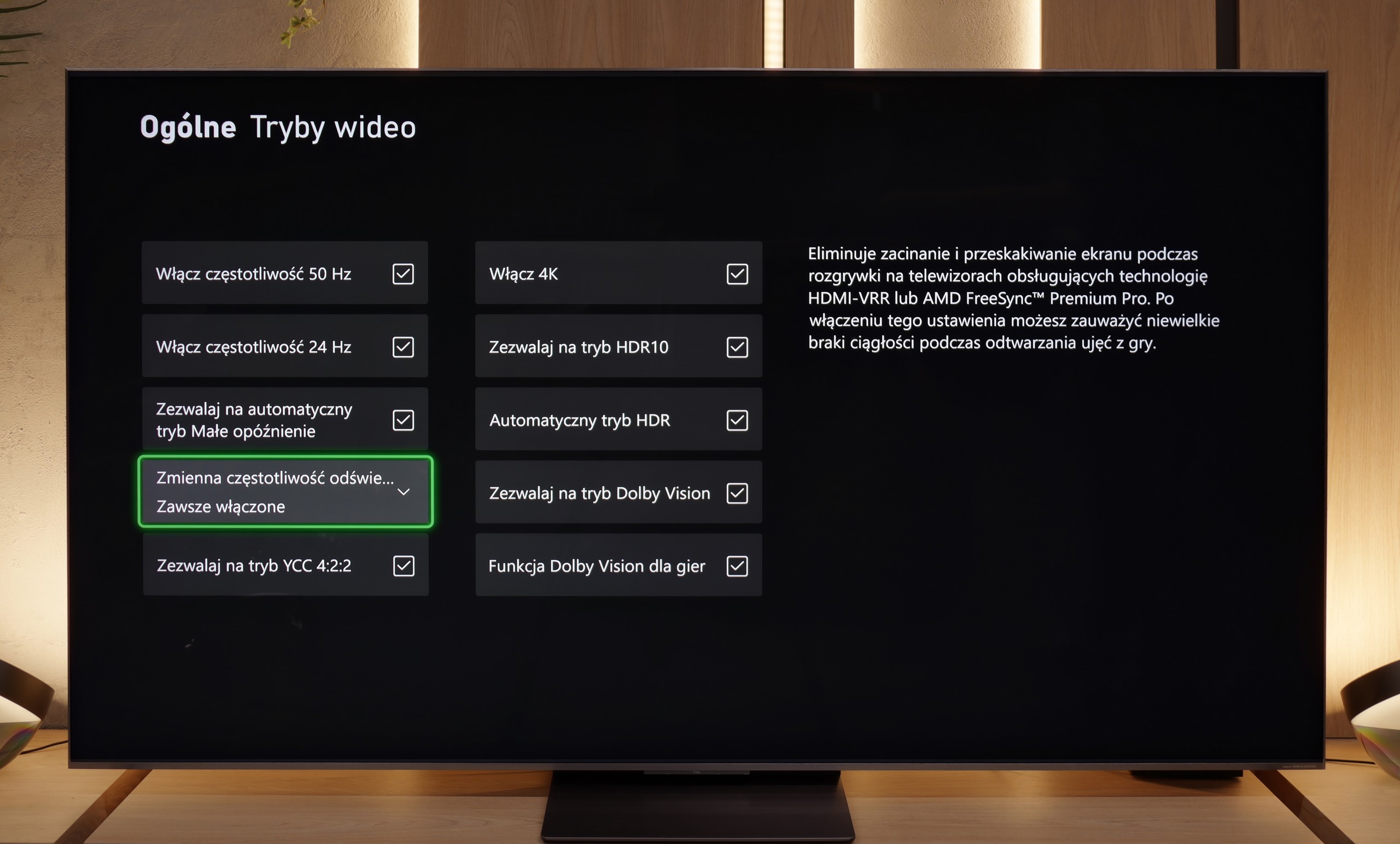

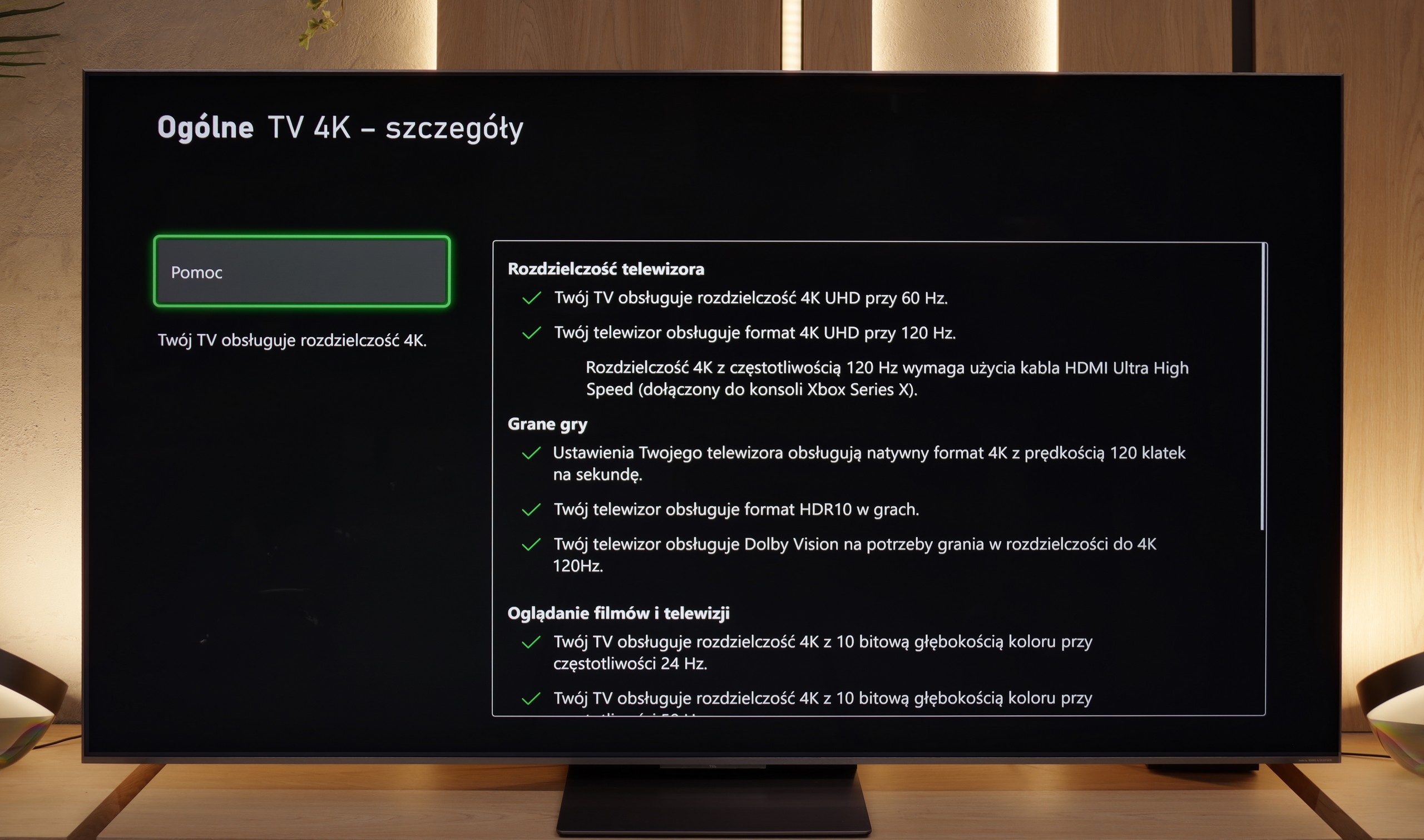

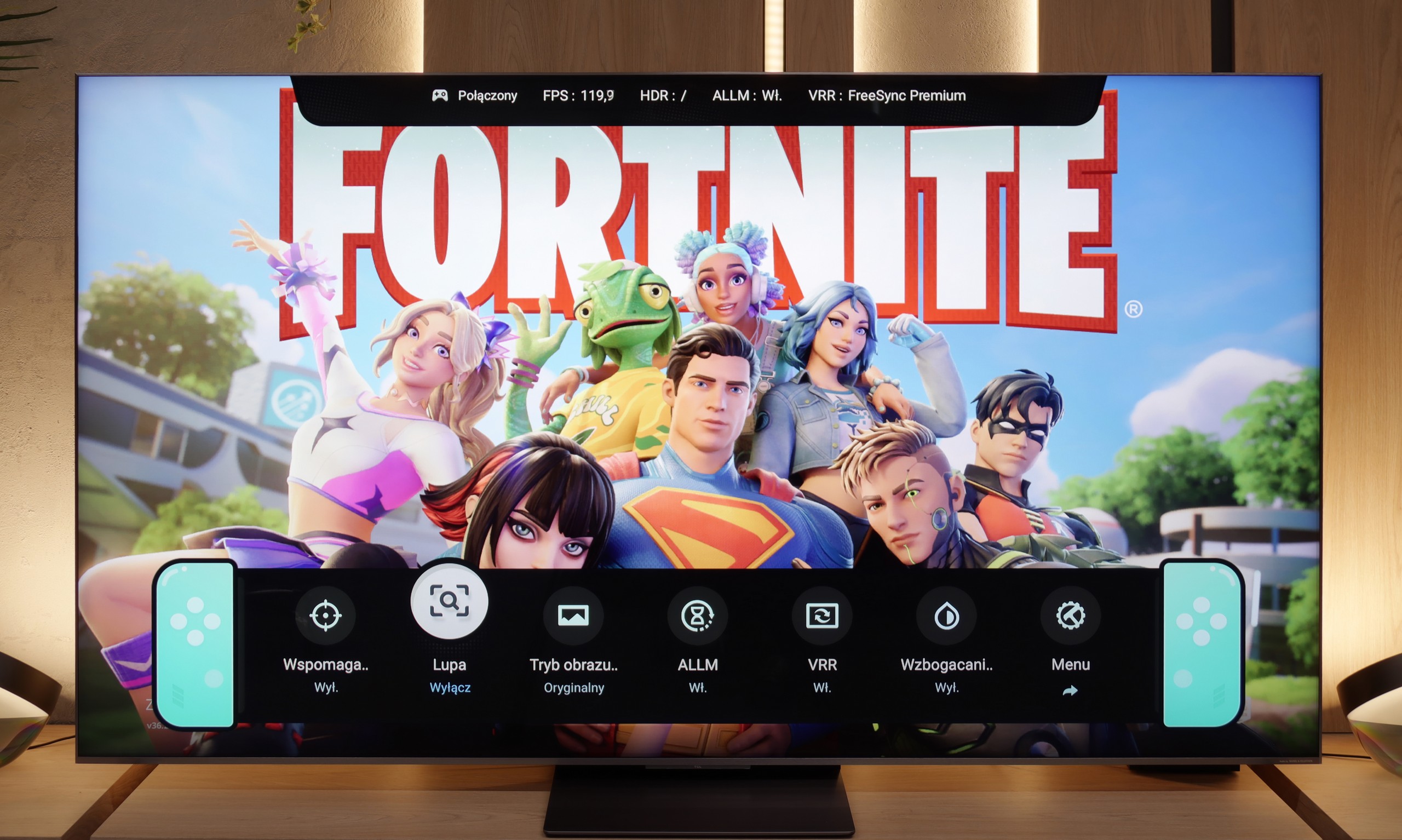

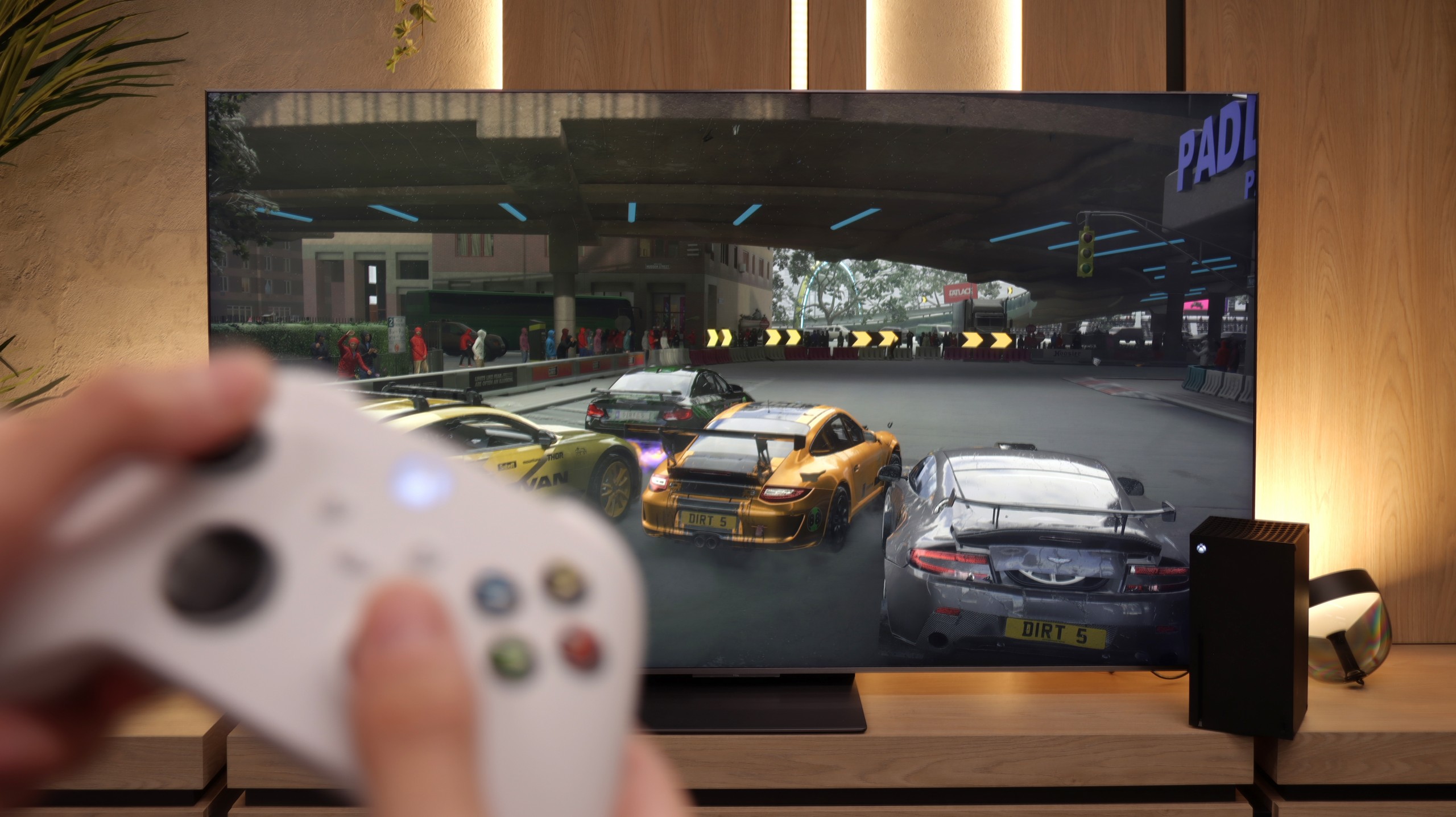
The television Samsung QN92/QN90 is an excellent choice for avid gamers, deserving of the highest recommendations. This model offers practically all the features available on the market in terms of gaming, making gameplay even more exciting. One of the key differentiators is the 120 Hz panel, which ensures exceptional motion smoothness, crucial during dynamic action games. The television also boasts low input lag, guaranteeing instant reactions to player commands. Additionally, technologies such as VRR (Variable Refresh Rate) and ALLM (Auto Low Latency Mode) adjust the refresh rate and automatically switch the television to game mode, translating to even better gaming experiences. Another advantage is the Xbox app, which allows gaming of favourite titles directly on the television, eliminating the need for a console. This is a typical feature of Samsung televisions, making them exceptional in the gaming world.
Auto Motion Plus Game is a feature that really deserves praise for Samsung. It is a motion smoother that works wonderfully in games, creating the impression of a higher frame rate – a 30 frames per second image looks like 45, and 60 Hz becomes close to 90 Hz. Importantly, this feature does not introduce significant lag (input lag does not exceed 25 ms), so it does not negatively affect gameplay comfort, unlike many other smoothers available on the market. This allows gamers to enjoy a much smoother image without compromising responsiveness.
TCL C8K offers practically everything we could expect from a screen for gamers. It has variable refresh rate (VRR), automatic game mode (ALLM), Dolby Vision in games, and a well-functioning implementation of HGiG, which helps preserve the creators' intent in HDR titles. The TV also supports 120 Hz in lower resolutions without any problems, and it can even display a staggering 288 Hz in Full HD – a figure that will surely appeal to fans of dynamic shooters and sports games on PC.
On board, we also find the GameBar – a graphical interface that somewhat resembles an elongated Nintendo Switch console. Thanks to this, we gain quick access to information about the current game mode, frame count, HDR format, and other little details that really make life easier for the gamer. We obviously couldn’t resist and ran a couple of races in Forza Horizon on the C8K – and we must admit, it looked and worked really well.
However, there is a slight drawback – in such a fast and clearly gaming-oriented device, it's a bit unfortunate that the manufacturer opted for the implementation of only two HDMI 2.1 ports. For some users, who use several next-gen consoles and, for example, a soundbar with eARC, this could be a limitation that’s hard to overcome.
Input lag
9.9/10
9.9/10
SDR
HDR
Dolby Vision
The input lag category is crucial for gamers, and the Samsung QN90D performs exceptionally well in this aspect. Input lag values below 13 ms are impressive, meaning that the delay between pressing a button on the controller and the reaction on the screen is minimal. Such a low value allows for smooth and responsive gaming experiences, which will certainly please both casual gamers and professionals for whom every millisecond of reaction time matters. This makes the Samsung QN92D an excellent choice for those who value precision and speed in gameplay.
In terms of delays, the TCL C8K pleasantly surprised us. Whether we were playing in 4K at 60 Hz, 120 Hz, or even in Full HD with Dolby Vision – the input lag remained at a very low level. This is a rare sight, as many TVs lose their advantage here, especially with more demanding Dolby Vision GAMING picture settings.
Compatibility with PC
8.6/10
8.6/10

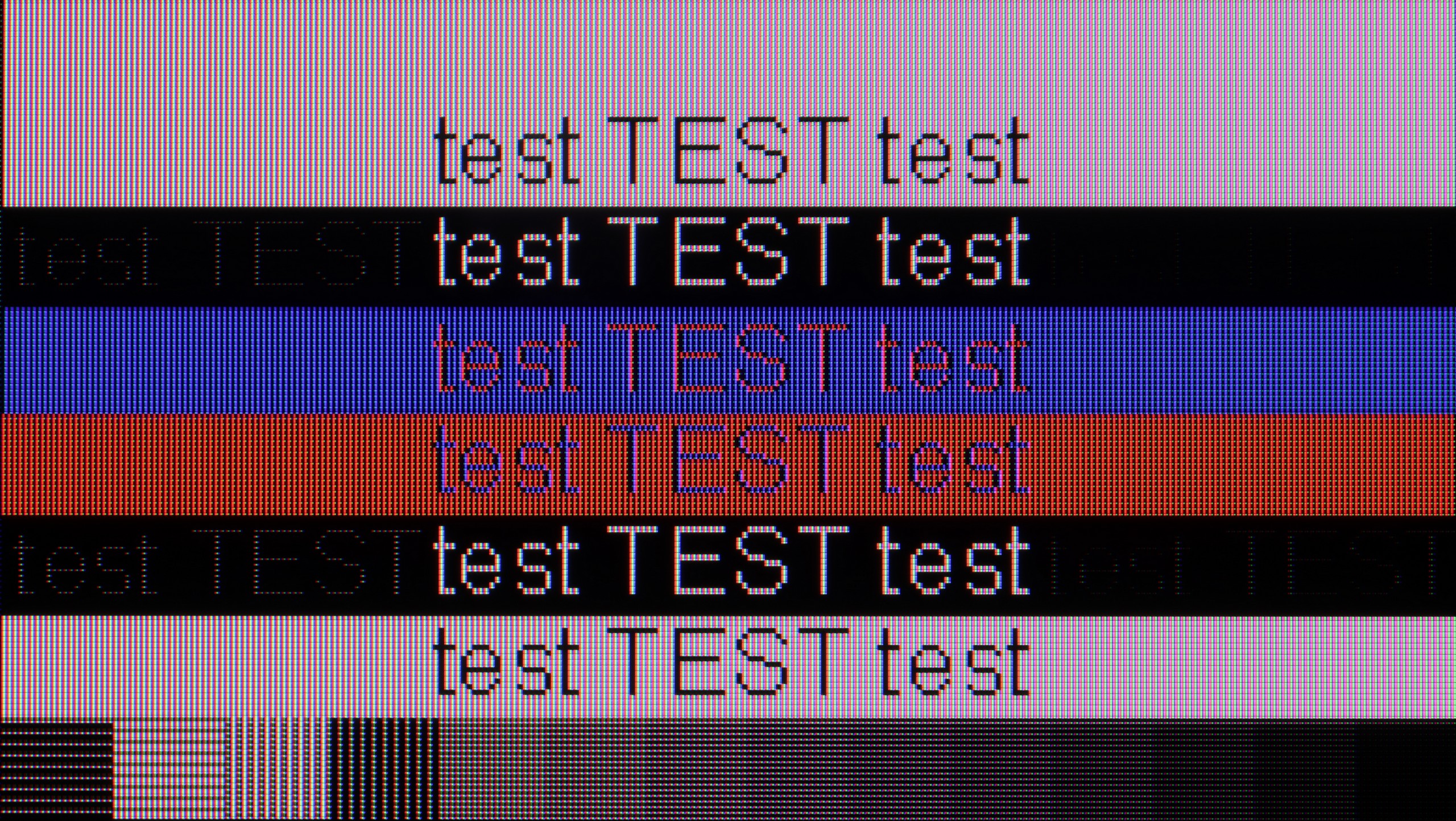
The television stands out with its high performance, supporting chroma 4:4:4 and offering exceptionally low input lag. These features allow users to enjoy fluidity and responsiveness, making it an excellent choice for office work and everyday applications. However, one noticeable drawback is the poor visibility of horizontal lines on dark backgrounds. On the test screen, letters on the right side appear more like vertical lines, which can be frustrating for some users. Nonetheless, the television generally works well with a computer, providing comfort in carrying out daily tasks. It’s also worth mentioning in this paragraph the "Remote PC" feature; thanks to Microsoft’s collaboration with the Korean giant, we can seamlessly pair Windows PCs and use Office 360 apps.
As we mentioned before, the C8K is a TV designed with gamers in mind – and not just console gamers. Connecting a PC is an absolute joy. The low input lag is practically unnoticeable, and the 4K panel at 144 Hz (or even 288 Hz in Full HD) makes gameplay exceptionally smooth. It's equipment that's really hard to pull away from when we connect a keyboard and mouse.
It also performs well for office work or everyday computer use. Fonts – regardless of size – are clear and sharp thanks to Chroma 444. However, we have a small note: with very thin horizontal lines, you can see slight imperfections. We assume that very few will notice this because, after all, hardly anyone plans to place the smallest 65-inch monster 50 cm from their face and use it like a regular monitor.
Viewing angles
7.1/10
4.5/10
In the case of TVs with VA panels, you can usually expect limited viewing angles, however Samsung QN90D surprises in this category. Thanks to the applied coating that widens the viewing angles, the TV offers really good performance, which is rarely seen in devices with this type of panels. Although VA panels are typically not the best in this regard, in this model the image remains clear and saturated even when viewed from the side, making it a great choice for larger rooms and group viewing.
One of the innovations in this year's TCL series is the WHVA panel, which has finally made a step forward in terms of viewing angles for the Chinese manufacturer. And while you can't completely cheat physics – brightness does indeed drop noticeably when viewed from the side – the image itself remains clear and doesn’t drastically lose colours or contrast. This is a significant change, as VA panels typically fall short compared to IPS panels in this category. Meanwhile, in the C8K, it’s clear that TCL has made an effort so that even a viewer sitting a little to the side can still enjoy the full image – something that everyone who doesn't sit "right in the perfect middle of the sofa" will appreciate.
TV efficiency during daytime
6.4/10
6.9/10

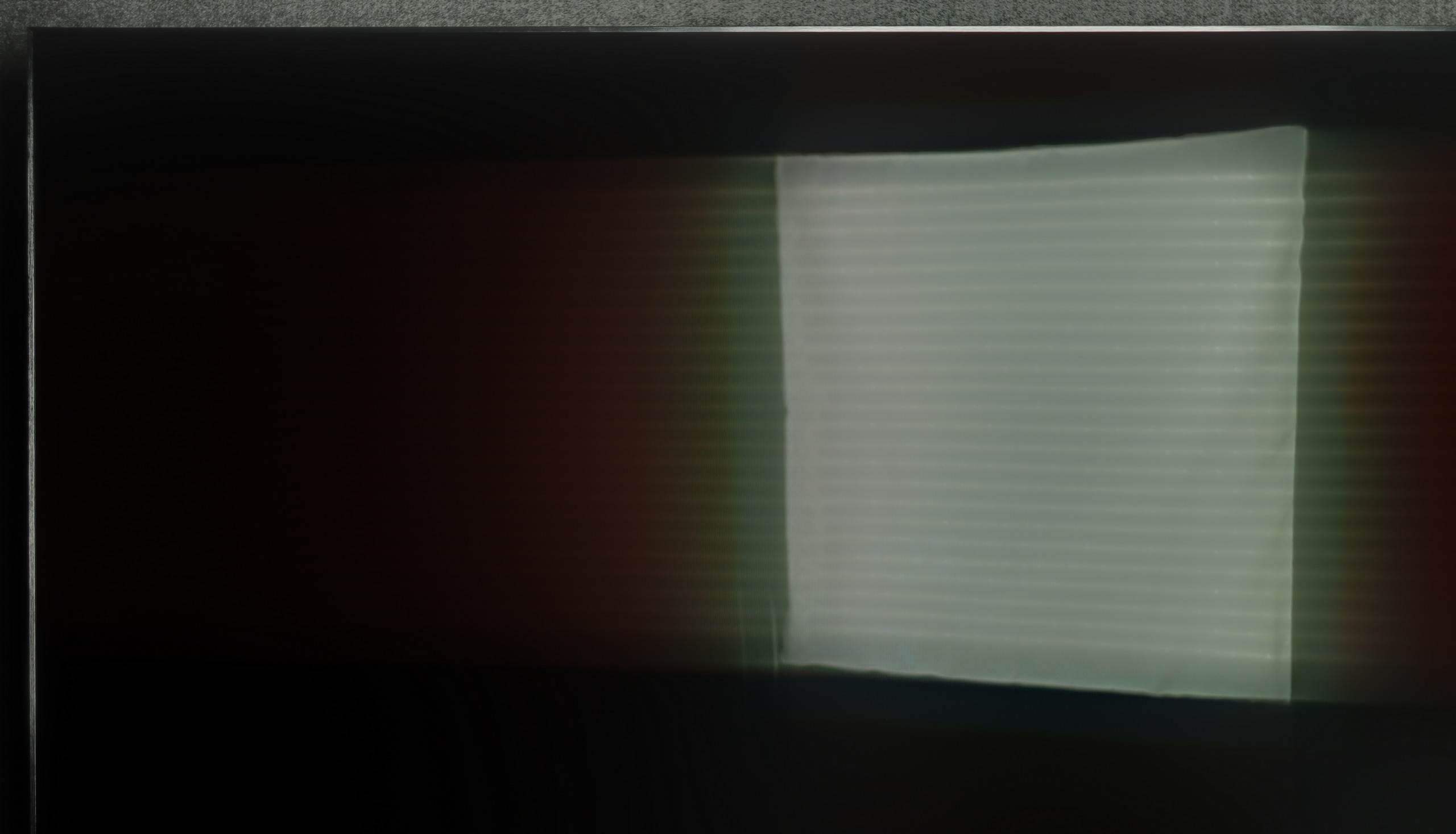


Matrix brightness
Average luminance SDR
TCL C8K: 613 cd/m2
Samsung Neo QLED QN90D / QN92D: 629 cd/m2
The television performs well in bright rooms due to its high brightness, especially when watching standard television. A constant brightness level of 600 nits ensures excellent visibility even in intense daylight. Unfortunately, despite the use of a satin finish, handling reflections is average, which can affect viewing comfort. An additional downside is the matrix that improves viewing angles, which causes reflections of sunlight to spread vertically, potentially further reducing viewing comfort in a bright environment.
C8K is a really bright performer, and not just in theory. In SDR content, it can reach an impressive 700 nits, which translates to very good image readability even in brightly lit rooms. So if you have a bright living room with large windows – this TV won’t have much of a problem. However, it’s worth mentioning one little detail: the WHVA panel used here with improved viewing angles causes light reflections to be more diffused to the sides. In practice, this means that, for example, wall sconces or floor lamps directly opposite the screen may reflect in a slightly more extensive way than in typical glossy/satin panels.
Details about the matrix
Subpixel Structure:

Panel uniformity and thermal imaging:


TV features
7.4/10
7.7/10
- HDMI inputs0 x HDMI 2.0, 4 x HDMI 2.1 48Gbps2 x HDMI 2.0, 2 x HDMI 2.1 48Gbps
- OutputsToslink (Optical audio), eARC (HDMI), ARC (HDMI)Toslink (Optical audio), eARC (HDMI), ARC (HDMI)
- Network InterfacesWi-Fi 2.4GHz, Wi-Fi 5GHz, Ethernet (LAN) 100MbpsWi-Fi 2.4GHz, Wi-Fi 5GHz, Ethernet (LAN) 100Mbps
- TV receptionDVB-T, DVB-T2, DVB-S, DVB-S2, DVB-CDVB-T, DVB-T2, DVB-S, DVB-S2, DVB-C
Classic features:
- Recording to USB (terrestrial TV)
- Recording programming
- Picture in Picture (PiP)
- RF remote control (no need to aim at the screen)
- Backlit remote control
- Teletext
- Audio only mode
- Bluetooth headphones support
- Simultaneous Bluetooth headphones & TV audio
Smart features:
- AirPlay
- Screen mirroring (Windows Miracast)
- Voice search
- Voice search in native language
- Ability to connect a keyboard and mouse


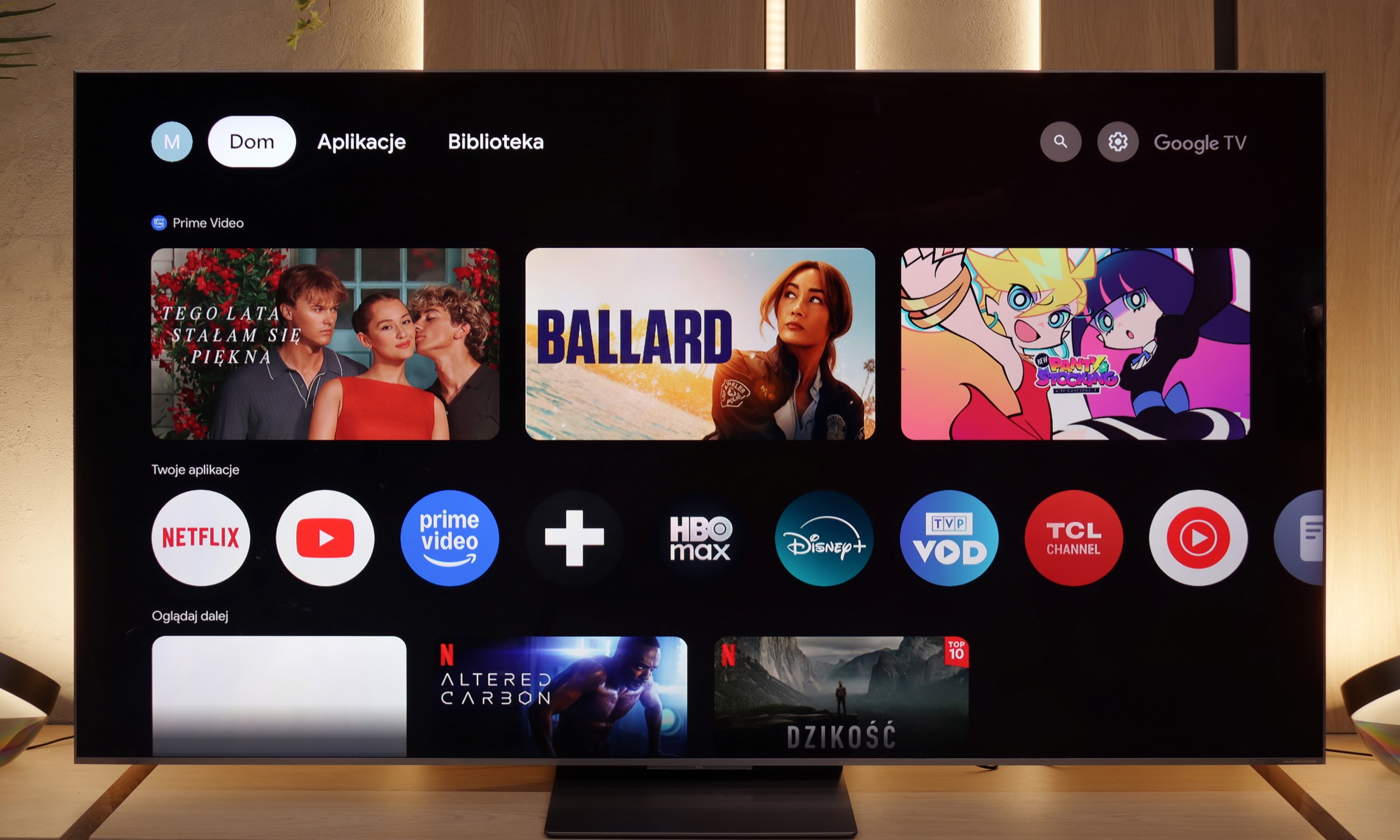
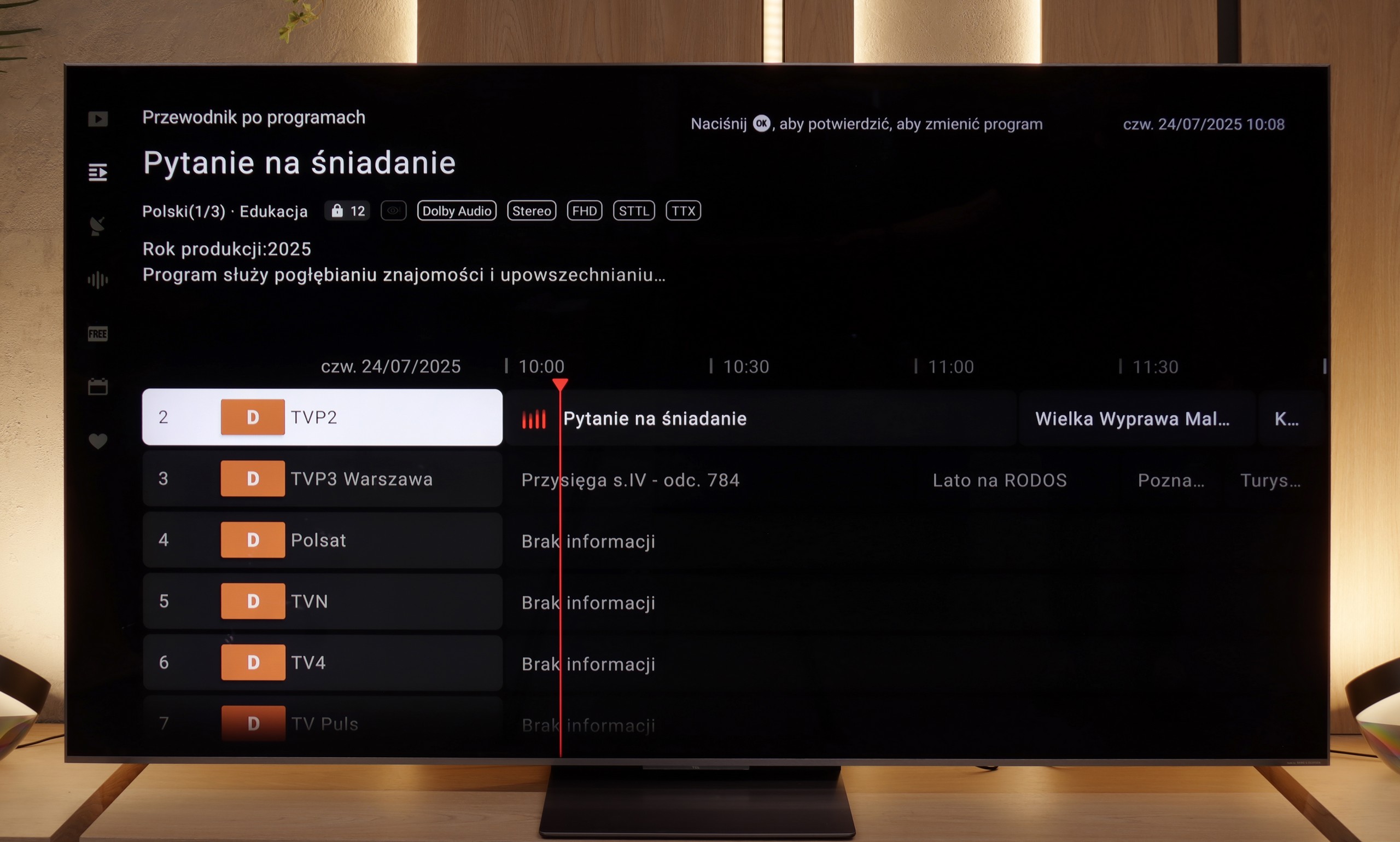
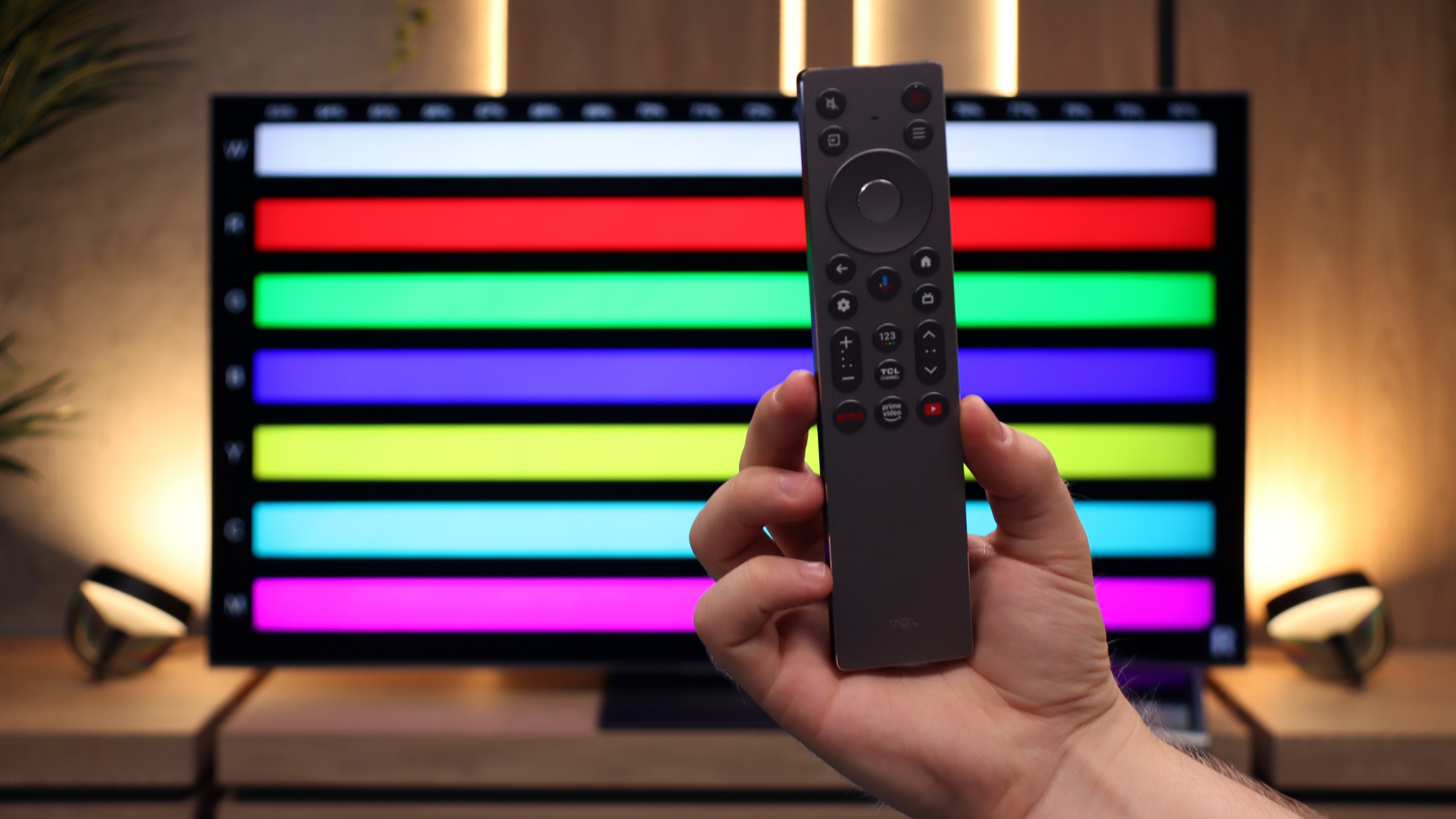
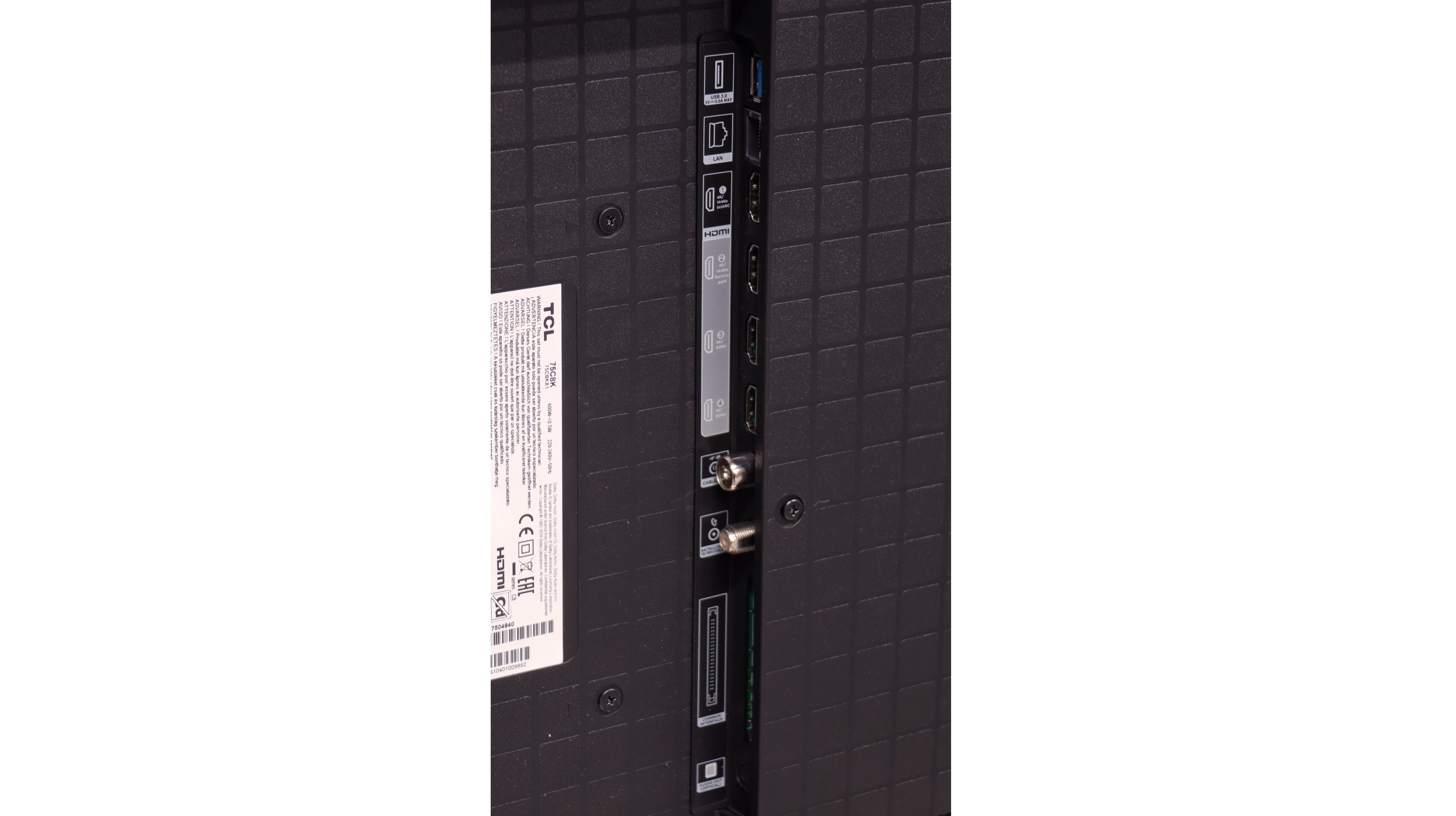
The Samsung QN92D television features a modern Tizen operating system, which offers users an intuitive and visually appealing environment. Tizen ensures smooth and fast navigation through applications, significantly enhancing the comfort of using the television. With an extensive ecosystem, users can easily connect the QN92D to other devices. The television supports many features that make everyday use easier, such as controlling set-top boxes with the remote, eliminating the need for multiple remotes. With AirPlay functionality, Apple device users can effortlessly stream multimedia from their iPhone. Additionally, there is a remote PC feature that allows users to access their computer on a large screen, as well as the Office 365 application, making the QN92D an ideal solution for both work and entertainment.
Furthermore, like many Samsung televisions, the QN92D offers Ambient Mode, which allows users to customise the appearance of the television to blend in with its surroundings. Users can display a variety of images or information, turning the television into an elegant part of the interior decor, even when not in use. Speaking of decor, it’s certainly worth mentioning the device's appearance. It is really very slim, around 2cm at its thickest point, which is impressive. The metal frame definitely gives the impression of a premium device, and the stand included in the box is sturdy.
However, for those using traditional television, the QN92D may prove to be a bit disappointing, as there is no television programme recording function available in the Polish market. Nevertheless, the television offers a Picture-in-Picture (PiP) feature that allows for simultaneous viewing of two programmes at the same time. The Samsung QN92D is a television with rich functionality that caters to both gaming enthusiasts and multimedia users, and it aesthetically fits into modern interiors.
Classic TV Features
TCL C8K offers the vast majority of features that we consider essential today. It has a classic and clear program guide (EPG), teletext functionality, and connecting a keyboard, mouse, or Bluetooth headphones was no problem at all. It's a bit of a shame that the Google TV system – like many other TCL models – lacks more advanced options such as program recording or picture-in-picture (PiP) functionality. For some users, this could be a downside, especially if they are used to these options with other manufacturers. There can also be some concerns about the number of USB ports – there is only one. However, in practice, most people will find this sufficient to connect a drive with movies or a USB stick.
Smart Features
While the classic TV features are not the strong suit of the C8K, when it comes to smart features, this TV really shows its claws. The Google TV system used is the largest and most popular platform on the market – and it shows at every turn. The availability of apps is phenomenal. Netflix, YouTube, Disney+, HBO Max, Amazon Prime – you can find all of these here without the slightest problem. Only really niche or closed ecosystems (e.g. Apple Music) may not be available. The built-in voice assistant works very efficiently – you can ask it to change the channel, launch an app, search for a movie, or check the weather. The system responds naturally and quickly, providing a genuine sense of convenience and modernity. This is where the C8K definitely outpaces much of the competition – after all, that’s why we have smart TVs, to do more than just display an image.
Playing files from USB
9.1/10
9.2/10
Supported photo formats:
Maximum photo resolution:

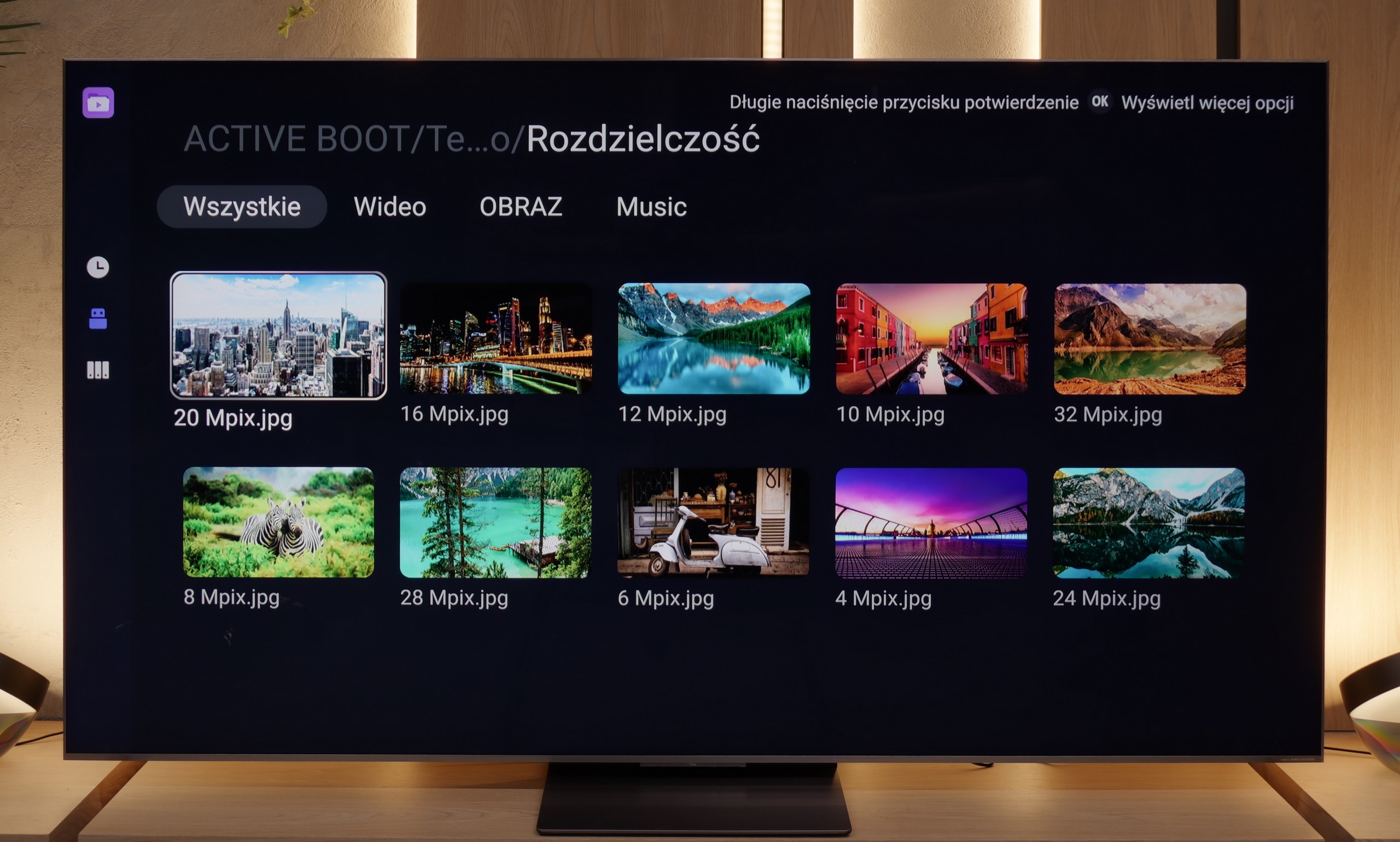
The built-in player in QN90D should satisfy a large portion of users. It will easily handle most popular video and audio formats. However, more demanding users may notice some shortcomings – it is not possible to play photos in HEIC format, which is popular on Apple devices, as well as several other, less common photo formats.
We weren't expecting miracles, but... we got more than we anticipated. The TCL C8K handled most of the files we threw at it on the USB stick without issue. Movies in MKV, older AVI, audio tracks in DTS or AC3 – everything worked without a hitch. If we had to nitpick, it would be the usual complaint about the lack of support for the HEIC format from Apple devices, but that's a standard shortfall that one can live with. The most important thing, however, is that if someone is missing something, they can simply... install a better player. And this is where the advantage of Google TV is felt.
Apps
8.7/10
9.6/10














































Sound
6.9/10
7.9/10
- Maximum volume-77dB
- Dolby Digital Plus 7.1
- Dolby True HD 7.1
- Dolby Atmos in Dolby Digital Plus (JOC)
- Dolby Atmos in Dolby True HD
- DTS:X in DTS-HD MA
- DTS-HD Master Audio
The television is equipped similarly to the QN95 with a speaker system featuring a 4.2.2 layout with a total power of 70W (the exception is the 50' variant with a 2.2 layout and the 43' with a 2.0 layout). Despite its very slim casing, the television sounds loud and clear, and the overall sound is well balanced. Points were deducted as per standard practice for every other Samsung model for the lack of support for the DTS format. It's also worth mentioning the proprietary Q-Symphony feature, which allows you to synchronise the sound of the television with a Samsung soundbar.
In terms of sound, we usually don’t have high expectations. After all, a TV isn’t a Hi-Fi system. But... the C8K positively surprised us. A new feature in the latest top models from TCL is the collaboration with Bang & Olufsen, and – most importantly – you can really hear that it’s not just a marketing gimmick. After just a few minutes with the TV, it was clear that it sounds different than a typical “flat screen”. The sound is full with a slight but noticeable bass. Of course, we’re still talking about sound from the television, so it won’t compete with the cheapest soundbar with a subwoofer, but for the standards of built-in speakers – it's very good.
*During loudness tests, we noticed unusual behaviour from the audio system. When the slider was set to 100%, the TV reached about 76–78 dB, but you could tell it was trying to generate more power, after which the volume level was immediately corrected to the mentioned value. On the other hand, when we lowered the volume to about 70%, it initially dropped as expected, but then slowly rose back to the same level of 76 dB. This effect gives the impression of an aggressive limiter at work, which, regardless of the position of the slider, always brings the volume back to one level. We checked this behaviour several times, and in every case, the result was identical – no additional “smart” volume adjustment or AI functions were activated.
Acoustic Measurements
No acoustic data
77dBC (Max)
75dBC


